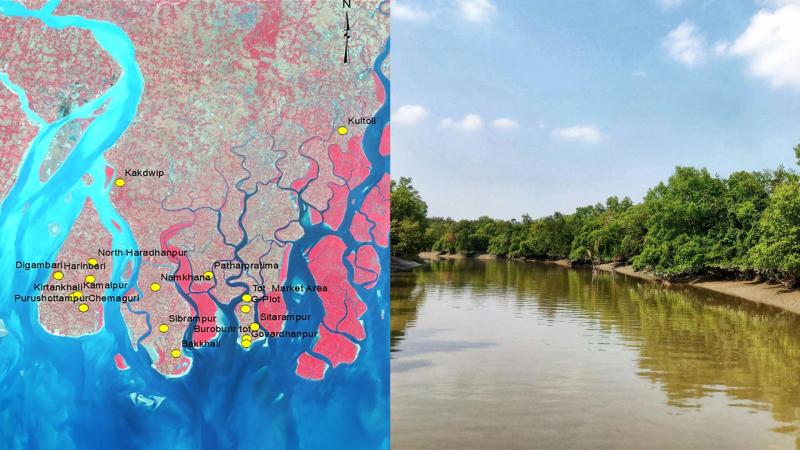
(Left)Image of Map of Sundarbans showing the 19 sampling locations. Credit:Authors, https://doi.org/10.1371/journal.pone.0333742
The world is grappling with the escalating impacts of climate change, and few regions feel this more acutely than coastal areas. Rising sea levels and increasingly frequent extreme weather events are devastating coastal ecosystems. One of the unanticipated threats from climate change has been soil deterioration. The rising waters are pushing saltwater farther inland, turning once-fertile agricultural lands into barren, salty stretches. This phenomenon, known as salinisation, poses a crisis for food security, particularly in vulnerable deltas such as the Indian Sundarbans, a mangrove forest formed by the confluence of the Ganges, Brahmaputra and Meghna Rivers in the Bay of Bengal and a biodiversity hotspot.
Researchers from the Indian Statistical Institute, Kolkata, have identified an unusual ally that could assist in our fight against salinisation: salt-tolerant bacteria. Their new research offers a detailed look at the chemical and microbiological characteristics of agricultural soils in this critical region. Unlike previous studies that often focused on the Sundarbans' mangrove forests, this team turned its attention to cultivated fields, aiming to understand how soil salinity, nutrient levels, organic content, and the presence of salt-tolerant bacteria vary across the landscape, and, more importantly, how these microorganisms might influence soil health.
The researchers collected 80 soil samples from 19 different sites across five blocks in the Indian Sundarbans. These sites represented a diverse range of agricultural practices. The samples were gathered post-harvest in both autumn 2020 and autumn/spring 2021, providing a snapshot of the soil's nutritional status after a growing season. The team specifically looked at two central cropping systems: monocropping, primarily paddy cultivation, and mixed cropping, which involved paddy alongside various vegetables. Water for these crops came largely from rain and pond irrigation, and farmers generally used common fertilisers such as urea, DAP, and superphosphate, sometimes supplemented with cow dung or vermicompost.
Did You Know? The Sunderbans, spread across 10,000 sq.km, is the world's largest mangrove forest and is of great economic importance as a storm barrier, shore stabiliser, nutrient and sediment trap, a source of timber and other natural resources, and as a habitat for a wide variety of aquatic, benthic, and terrestrial organisms. |
Back in the lab, the soil samples underwent a battery of tests. The scientists isolated salt-tolerant bacteria to further assess their resilience. Individual bacterial isolates were streaked onto agar plates containing 10% and 20% NaCl and incubated for a week. This process allowed the researchers to identify and quantify bacteria that could withstand, and even thrive in, saline environments. Beyond counting bacteria, they also estimated the Microbial Biomass Carbon (MBC), a measure of the total living microbial mass in the soil, which reflects overall microbial activity.
For chemical analysis of the soil, air-dried, finely ground soil samples were used. The team measured soil pH, soil salinity, organic carbon content, and available Nitrogen, an essential nutrient for plant growth. Once the soil was analysed, the researchers turned to spatial and statistical tools. They used ArcGIS 10.8 to create detailed maps that visually illustrate how parameters such as EC, Available Nitrogen, Organic Carbon, bacterial count, MBC, and the populations of 10% and 20% NaCl-tolerant bacteria are distributed across the Sundarbans. These maps revealed that the central Sundarbans had significantly higher salinity levels than its eastern and western counterparts. Interestingly, areas like Bakkhali, Sibrampur, Patharpratima, and certain villages on Sagar Island showed a higher abundance of salt-tolerant bacteria.
The statistical analysis allowed them to explore the distribution of soil characteristics. It also enabled them to compare the two cropping systems to determine whether there were significant differences in various soil parameters between monocropping and mixed cropping. Finally, they looked at how bacterial count depended on other factors like cropping system, EC, organic carbon, available nitrogen, and MBC.
The findings show that while the presence of salt-tolerant bacteria in saline regions was influenced by the types of crops cultivated, the effect was not as pronounced as they had suspected. The study concluded that most soil characteristics, including salinity, organic carbon, and available nitrogen, tended to vary primarily with spatial factors rather than specific cropping patterns. This suggests that broader geographical and environmental influences, such as proximity to the coast, tidal inundation, and local topography, play a more dominant role in shaping soil properties in the Sundarbans.
However, the bacterial count and the number of 10% NaCl-tolerant bacteria showed significant differences between monocropping and mixed cropping systems. Furthermore, the overall bacterial count was found to depend significantly on both the type of cropping system and the soil nitrogen availability. Crucially, the salt-tolerant bacterial strains isolated in this study were observed to increase available nitrogen levels, highlighting their potential benefits. The finding that higher values for microbial growth, microbial biomass carbon, and available nitrogen were achieved in monocropping areas, contrary to some previous studies that suggested benefits from mixed cropping, is particularly noteworthy. The authors attribute this to factors like increased rainfall in the region and the practice of adding rice husks to the soil after harvest, which can enhance fertility.
By understanding the spatial distribution and factors influencing salt-tolerant bacteria, farmers in the Indian Sundarbans and other saline-affected coastal regions can gain valuable knowledge to adapt their agricultural practices. The identification of specific salt-tolerant bacterial strains that increase available nitrogen levels offers a promising avenue for developing biofertilisers or soil amendments to improve crop yields in challenging saline environments. This work is a crucial step towards fostering resilient and sustainable agriculture, ensuring food security for communities on the front lines of climate change.
This article was written with the help of generative AI and edited by an editor at Research Matters.

![Dr Neena Gupta [Photo Credit: Arunita Banerjee] Mathematician Dr Neena Gupta shines as the youngest Shanti Swarup Bhatnagar awardee](/sites/researchmatters/files/styles/400px_wide/public/dr_neena_gupta.jpg?itok=YywTafEO)




